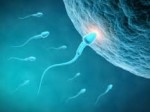 Despite the fact that fertilization requires mutual, active participation by both eggs and sperm, gender roles are often projected onto reproductive biology, leading to the portrayal of eggs as passive and sperm as active. For example, the opening credits in the 1989 movie Look Who’s Talking portray a common perception of fertilization. As the Beach Boys’ song “I Get Around” plays in the background, we see sperm inside a women’s reproductive tract moving toward her egg. The scene is narrated by one of the sperm, though we can hear some of the other sperm talking. The narrating sperm tells the others, “Ok, follow me … I know where we’re going … I’ve got the map. Follow me kids, keep up.” Upon seeing the egg, the sperm says “I think I see something … this is it, this is definitely it … jackpot!” to which another sperm relies “Yee haw!” We then see a bunch of sperm on the outside of the egg, seeking entrance through the egg membrane – a difficult task as evidenced by the lead sperm stating, “kinda tough here.” The egg then envelopes one sperm as it cries “Ohhh, ohh, I’m in, I’m in.” In this scene, the egg is portrayed as passive, merely drifting along waiting to be discovered by the sperm, whereas the sperm is active, strong, and on a mission to reach the egg.
Despite the fact that fertilization requires mutual, active participation by both eggs and sperm, gender roles are often projected onto reproductive biology, leading to the portrayal of eggs as passive and sperm as active. For example, the opening credits in the 1989 movie Look Who’s Talking portray a common perception of fertilization. As the Beach Boys’ song “I Get Around” plays in the background, we see sperm inside a women’s reproductive tract moving toward her egg. The scene is narrated by one of the sperm, though we can hear some of the other sperm talking. The narrating sperm tells the others, “Ok, follow me … I know where we’re going … I’ve got the map. Follow me kids, keep up.” Upon seeing the egg, the sperm says “I think I see something … this is it, this is definitely it … jackpot!” to which another sperm relies “Yee haw!” We then see a bunch of sperm on the outside of the egg, seeking entrance through the egg membrane – a difficult task as evidenced by the lead sperm stating, “kinda tough here.” The egg then envelopes one sperm as it cries “Ohhh, ohh, I’m in, I’m in.” In this scene, the egg is portrayed as passive, merely drifting along waiting to be discovered by the sperm, whereas the sperm is active, strong, and on a mission to reach the egg.
A colleague and I were interested in seeing if this misperception of fertilization is limited to the media or if it is also seen in scientific writing. We analyzed science textbooks from the middle school to the medical school level to determine if fertilization in human reproduction is described in gender biased language regarding the sentence structure, amount of information provided for female and male processes/parts, and neutrality in describing female and male processes/parts.
Unfortunately, we found that scientific textbooks tend to present the egg and sperm in ways that align with dominant gender norms. Indeed, many textbook accounts of fertilization read like a fairy tale—specifically like a courtship or romance—with the sperm as the “knight in shining armor” and the egg as the “damsel in distress.” We were surprised to find that gendered language was just as common at the higher levels (college and medical school) as the lower levels. In almost all textbooks, we encountered passive language to describe the egg (e.g. “the egg is fertilized” and “the egg is swept”). In contrast, sperm’s activities, including their death, were typically presented in active and often anthropomorphic terms. For example, the word “survive” was almost exclusively used for sperm, whereas the death of eggs was depicted in more scientific terms, such as “degenerate” and “disintegrate.”
At all educational levels, we found shorter explanations, fewer facts, and more misrepresentations about the female reproductive system than the male reproductive system. In particular, most textbooks had minimal information about the active role the egg plays in fertilization and limited or no information about female sexuality even when male sexuality was covered. Even those textbooks that spent more time discussing the female reproductive system often portrayed the female body negatively by selectively omitting certain facts. For instance, the majority of textbooks that described how the acidity of the vagina can deleteriously affect sperm failed to point out the ways the female body can help sperm (e.g. cervical mucus and vaginal lubrication aid in sperm transport). Additionally, the male reproductive system was subtly elevated in many textbooks by the consistent placement of male terms before female ones (e.g. “the sperm and egg” rather than “the egg and sperm”).
Endowing gametes with gendered personalities reifies gender norms, making them appear “natural” and innate. Sexist language in scientific textbooks undermines teachers’ ability to teach in an accurate and gender-neutral way. Furthermore, presenting science in a gendered way can deter girls and women from enjoying and considering a degree and/or career as a scientist. Overt sexist language and images in textbooks have been shown to have deleterious effects on both girls/women and boys/men and may reinforce the stereotype that science is just not for girls/women. In contrast, gender-neutral language in science textbooks, especially for reproductive biology, will encourage girls and women to partake in and develop an affinity for science.
Guest Blogger: Lisa Campo-Engelstein, Ph.D.
Assistant Professor
Alden March Bioethics Institute & Department of OBGYN
Albany Medical College
